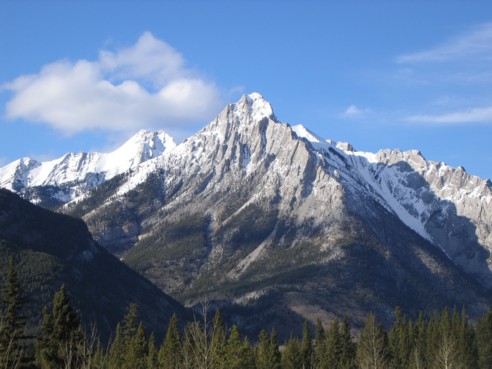
Mountain height: 2,487 m
(8,157 ft)
Elevation gain: 1,109 m
Ascent time:
6:40
Descent time:
2:30
Climbing with Mark.
This one felt good…it felt reeeal good! (must be an SCTV
fan of the 1980’s to understand!). With a recent string of disappointing
weather days on relatively insignificant mountains, we were really craving
something a little more challenging and rewarding – and
We returned to Lorette a year and a month after our first
failure, with a little more climbing experience and a lot more climbing gear,
though I certainly would have preferred the converse to be true. In addition to
adding cams, nuts, and pitons (in case of an emergency) to our climbing gear, we
also brought the hip-waders, to cross the frigid and surprisingly deep waters of
the Kananaskis
Initially, scrambling on the right side of the mountain protected us a little from the wind and so we ascended with relative ease. Continuing on towards the more difficult terrain, we suddenly noticed that the winds were dying down and the sky was clearing a little around us. Soon we took out the rope and started to set up belays. Once passed the first exposed section, I was quite relieved to find that the exposure had not bothered me half as much as on last year’s attempt. Another significant difference between the two days, was that on this day I was wearing a pair of Nike approach shoes (a great recommendation from Dave Stephens), as opposed to my size 11.5 scrambling boots. This helped increase my confidence greatly on the narrow and exposed ridge. Unfortunately, Mark was still stuck with his bulky, and very worn-out scrambling boots and so I led the route most of the way.
Having made it to the crux last year, before backing down, we were able to make fairly good time (no 30 minute debate on whether we could make it over the infamous gendarme, today!), and soon we were at the crux. Armed with some great instructions from Bill Kerr and a number of other helpful climbers from the Live-the-Vision message board, I carefully made my way over to the very precarious-looking, but solid, chockstone(s) and the start of the also infamous hand traverse. Standing on the small conglomeration of rocks, with nothing but air below, I couldn’t help but think of the “Aron Ralston story” that aired this past week (the very courageous man who severed his own arm after getting his hand trapped by an 800 lb chockstone).
Up to this point, all had gone well and the ascent had been problem-free. Well….we weren’t about to summit this little gem of a mountain without some sort of epic, so why not do it at the most dangerous and exposed section! The hand traverse consists of a short, slightly upward traverse, where you shimmy your way across the east side of the mountain with your hands in a large crack, supporting a good deal of your weight. Since there are few ledges or features for your feet, you have to be very confident that if your feet slip, you can hold on with your hands and arms only. I hadn’t read the accident report at the time, but it seems that this traverse was the scene of one of the fatalities of 2003.
To make a very long story short, in my haste to complete the hand traverse, in order to prevent the rope from getting stuck on the rock, I neglected to attach a small sling to the one cam I placed. The rope did get stuck, and after a couple of very tense moments where I found myself hanging in mid-air, right in the middle of the traverse, unable to move, the rope came free and I completed the section. Unfortunately, the rope became lodged again, making it impossible for me to belay Mark over. This meant that he would have to traverse over to the chockstone with a self-belay. Leaving a sling at the top, he climbed down a 2 m step and then over to the chockstone, where he freed the rope. (Lesson number 843 from the continually growing catalogue of “Nugara Bloopers and Blunders for the Young Mountaineer”: always use webbing in conjunction with placed protection to keep the rope away from the rock.)
I was starting to get a little worried at this point: the traverse had taken a solid hour, bad weather was rapidly approaching from the west, it started to snow a little, and my hands were freezing, having sat on a knife-edge ridge for an hour without moving. There was no time to take our time anymore and I quickly belayed Mark over the hand traverse. He later confessed to me that the traverse unnerved him to the point where he actually closed his eyes while doing it!
The last obstacle was a very intimidating looking gendarme. Again, with good instructions, I was able to quickly climb up the gendarme, although at one point, a step across a very narrow and severely exposed ledge almost ended in a fall. Mark avoided the ledge by coming straight up the steep and exposed rock face. Rarely do I pray on a climb, but I’ll be the first to admit, a couple of “Hail Mary’s” were whispered when we where both on top of the gendarme and looking at the easier terrain, leading to the summit.
The remainder of the climb was a combination of very pleasant ridgewalking and scrambling and was thoroughly enjoyable in dramatically improving weather conditions. We arrived at the summit in great spirits, to a spectacular view all around. Especially stunning was the higher and unnamed summit further along the Lorette/McGillivray ridge – a trip for another day. We deserved and therefore took an extended stay at the summit, eating Gummy Worms, taking in the magnificent scenery, and laughing about some of the more dire moments of our minor epic ascent. Great stuff!
The descent, down scree slopes east of the ascent route, was heaven. Granted, it was about as ascetically pleasing as going on a date with a supermodel who has viciously bad gas, but no exposure, no knife-edges, no stuck rope, no belaying, no hanging precariously onto ledges, no chockstones, no gendarmes, and no fear of slipping, plummeting and/or dying. And though the terrain was mundane, the scenery continued to be fantastic – the tremendously big and vertical east face of Lorette was breath-taking, as were the magnificent walls and rock formations of the ridge on the left side of the descent gully.
A truly phenomenal day in the mountains!
The southeast ridge of Mount Lorette (photo taken in March of 2005)
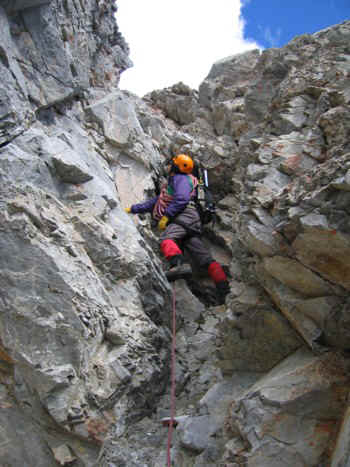
Mark looks for a way up steep terrain

Onto the narrow ridge
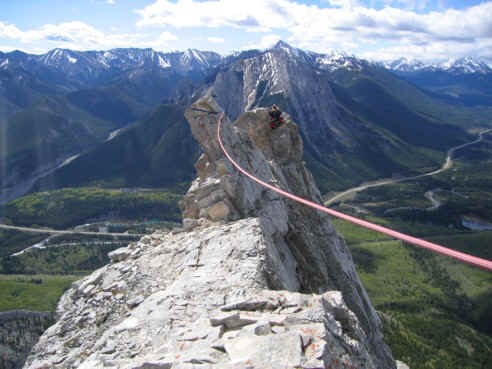
Belaying across the infamous gendarme; a long sling around the gendarme works wonderfully here
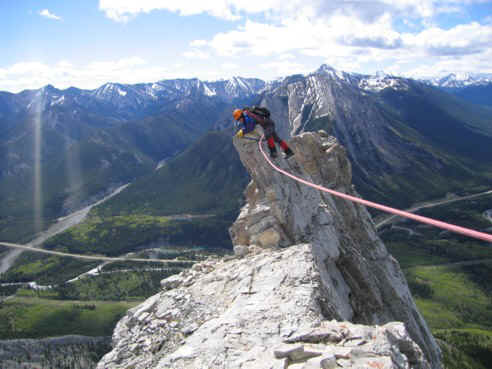
Mark, climbing around/over the gendarme

One of the more challenging rockbands that must be ascended
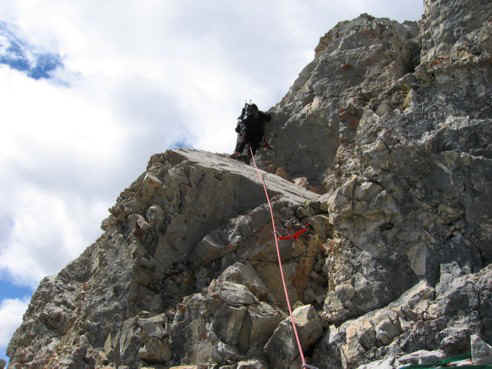
Ascending the above rockband; here, I had enough sense to attach a small sling to the cam; who knows what I was thinking later???

At the crux once again; the hand traverse is the crack just above my head, to the left; exposed terrain then leads to the gendarme, just right of centre, that must be ascended
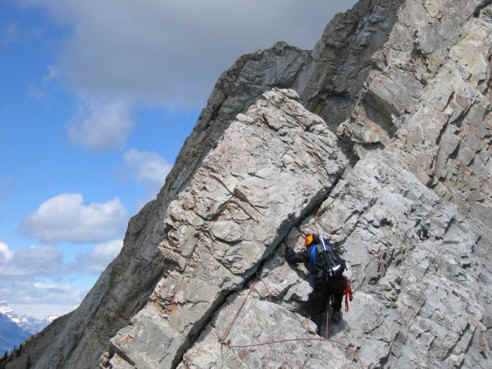
Doing the hand traverse; note the skills of the talented belayer/photographer
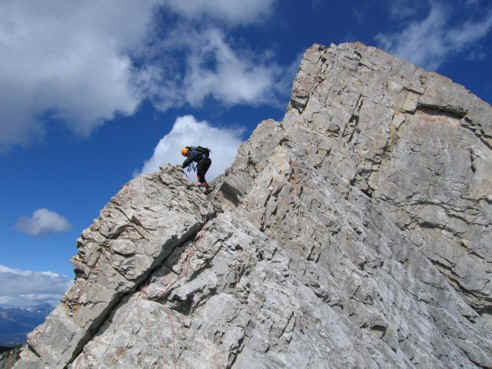
At the top of the hand traverse; this is where the rope got caught
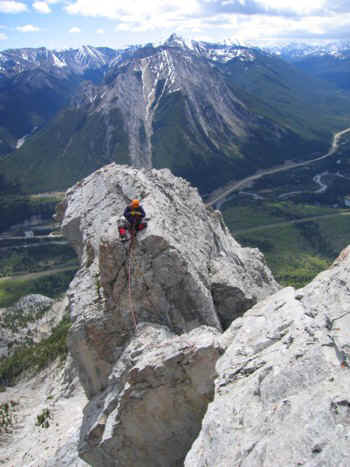
Looking back at Mark from the other side of the traverse; he had to self-belay down the downclimb and over to the chockstone (not visible here)
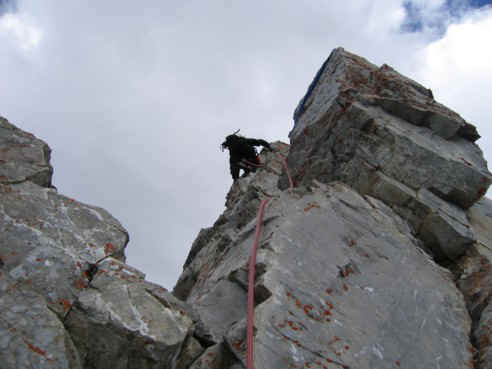
Climbing the final gendarme
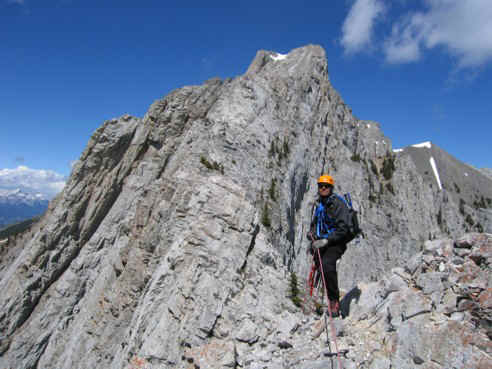
Atop the gendarme, with the pleasant scramble to the summit behind
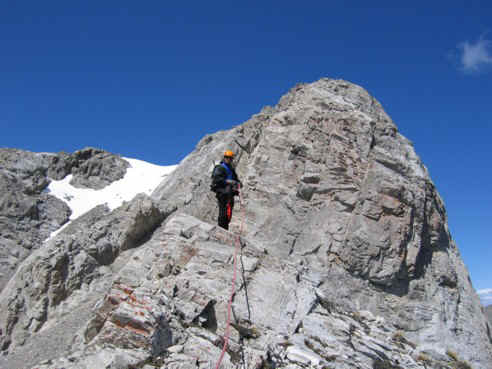
The final rock step before the summit
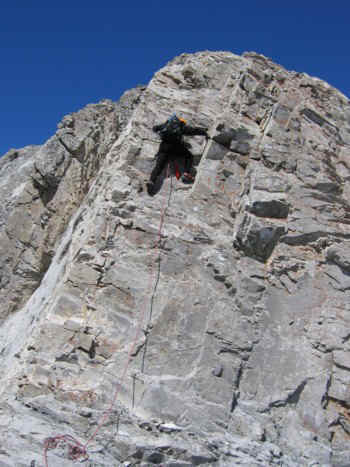
Ascending the final few metres

Mark at the summit
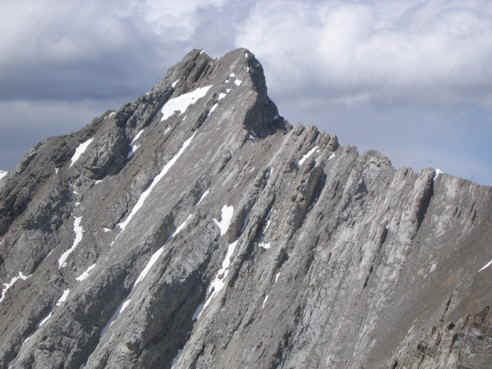
The highest point of the Lorette/McGillivray traverse; surprisingly, the peak is unnamed

On descent, Mark looks up the beautiful vertical face of Lorette's east side
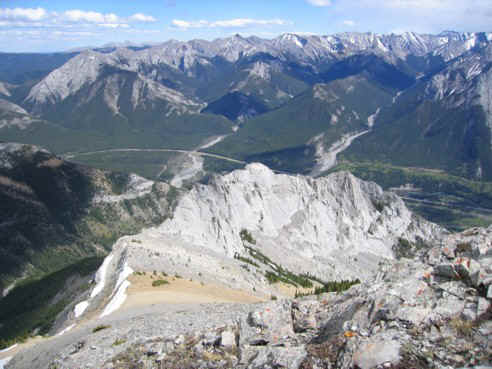
Looking down the easy descent the the scenic ridge to the east

Unnamed in the background; me in the fore

One more shot of the route towards Unnamed
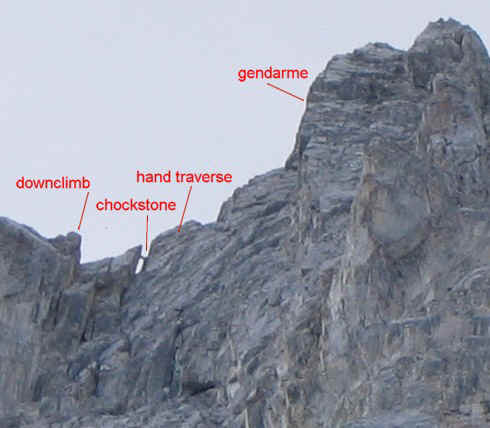
A very zoomed-in photo of the crux section, taken on descent
Epilogue: less than two weeks after completing this ascent, the famous chockstone fell and now you must step (jump) over that gap.